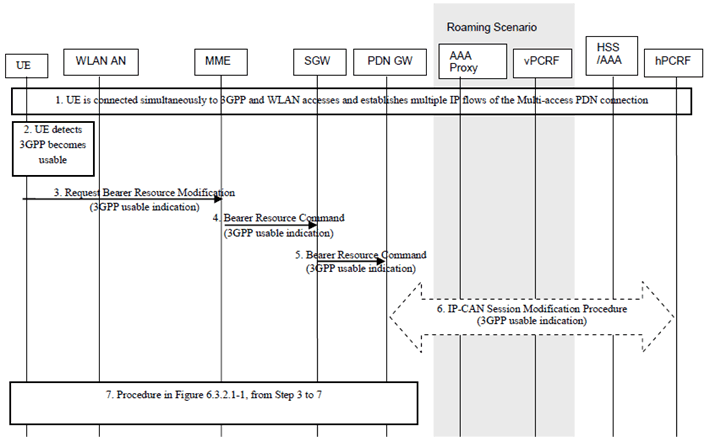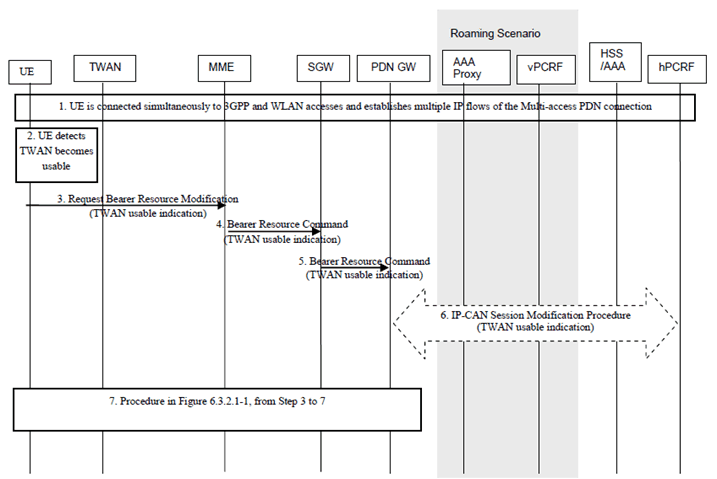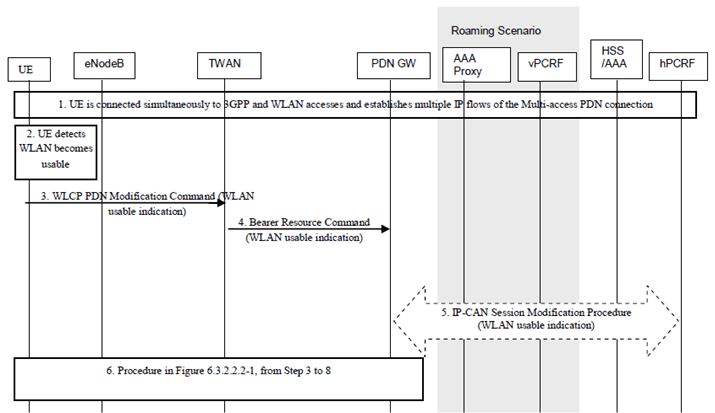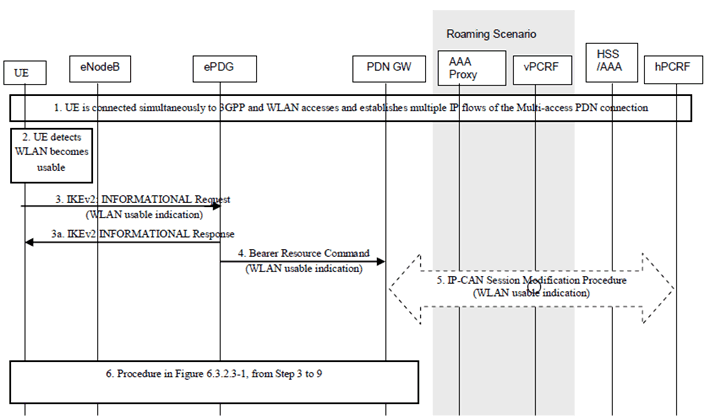Content for TS 23.161 Word version: 18.0.0
1…
5…
6…
6.2…
6.2.4
6.3…
6.3.2.2…
6.3.3…
6.3.3.2…
6.4…
6.4.2.2…
6.5…
6.5.2…
6.5.3…
6.6…
6.6.1.3…
6.6.2…
6.7…
6.7.2…
6.8…
6.6.2 An access of a PDN connection becomes usable
6.6.2.1 3GPP access for the PDN connection becomes usable
6.6.2.2 Trusted WLAN access for the PDN connection becomes usable
6.6.2.3 Untrusted WLAN access for the PDN connection becomes usable
...
...
6.6.2 An access of a PDN connection becomes usable p. 54
6.6.2.1 3GPP access for the PDN connection becomes usable p. 54
When the UE detects that the 3GPP access becomes usable, the UE shall report this event to the network via 3GPP access. The UE determines that the 3GPP link is usable again when it detects recovery of 3GPP coverage, or 3GPP radio quality allowing the usage of this access based on UE implementation mechanism. This procedure is applied in Network-initiated NBIFOM mode.

Figure 6.6.2.1-1: Procedure for 3GPP access becomes usable for GTP S5/S8
(⇒ copy of original 3GPP image)
(⇒ copy of original 3GPP image)
Step 1.
The UE is connected simultaneously to 3GPP and WLAN accesses and the UE has previously reported that the 3GPP access link is not usable for routing IP flows.
Step 2.
The UE detects that the 3GPP link becomes usable.
Step 3.
The UE sends the Request Bearer Resource Modification message including a 3GPP usable indication.
Step 4-5.
The indication is sent to the PDN GW via the SGW within a Bearer Resource Command.
Step 6.
When the PCRF has subscribed to such notification, the PDN GW sends the indication to the PCRF.
The PCRF updates the PCC rules, e.g. by changing the Routing Access Type of PCC Rules and provides the updated PCC rules to the PDN GW. The PCRF does not provide updated PCC rules for those IP flows which are forbidden to be routed in the 3GPP access.
Step 7.
The PDN GW provides updated Routing Rules to the UE based on the updated PCC rules received from PCRF.
The PDN GW may initiate dedicated bearer activation and/or modification procedure according to if the IP flow shall be transported to new dedicated bearer or to existing bearer. In case IP flows are moved from WLAN access to 3GPP, the PDN GW may release the resource in the WLAN access network but do not release the access from the multi-access PDN connection. Step 3 to 7 as per Figure 6.3.2.1-1 will be invoked.
6.6.2.2 Trusted WLAN access for the PDN connection becomes usable p. 55
6.6.2.2.1 Single-connection mode p. 55
After the UE connects to WLAN access and SCM mode is used, the UE shall report to the network, via 3GPP access, that TWAN is usable. This procedure is applied in Network-initiated NBIFOM mode.

Figure 6.6.2.2.1-1: Procedure for Trusted WLAN access becomes usable for GTP S5/S8 in SCM
(⇒ copy of original 3GPP image)
(⇒ copy of original 3GPP image)
The procedure is similar to 3GPP access becomes usable call flows in clause 6.6.2.1, with the following differences:
- Step 2 the UE detects TWAN becomes usable.
- Step 3 to Step 6, the TWAN usable indication is sent from the UE to the PCRF instead of 3GPP usable indication.
6.6.2.2.2 Multi-connection mode p. 56
After the UE connects to WLAN access and MCM mode is used, the UE shall report to the network, via 3GPP access, that TWAN is usable. This procedure is applied in Network-initiated NBIFOM mode.

Figure 6.6.2.2.2-1: Procedure for Trusted WLAN access becomes usable for GTP S2a in MCM
(⇒ copy of original 3GPP image)
(⇒ copy of original 3GPP image)
Step 1.
The UE is connected simultaneously to 3GPP and TWAN accesses and has previously reported that the 3GPP access link is not usable for routing IP flows.
Step 2.
The UE detects that the WLAN link is again usable for carrying IP flows.
Step 3.
The UE sends the WLCP PDN Modification Command message including a WLAN usable indication.
Step 4.
The indication is sent to the PDN GW within a Bearer Resource Command.
Step 5.
When the PCRF has subscribed to such notification, the PDN GW sends the indication to the PCRF.
The PCRF updates the PCC rules, e.g. by changing the Routing Access Type of PCC Rules and provides the updated PCC rules to the PDN GW. The PCRF does not provide updated PCC rules for those IP flows which are forbidden to be routed in the TWAN access.
Step 6.
The PDN GW provides updated Routing Rules to the UE based on the updated PCC rules received from PCRF.
The PDN GW may initiate dedicated bearer activation and/or modification procedure according to if the IP flow shall be transported to new dedicated bearer or to existing bearer. In case IP flows are moved from 3GPP access to WLAN, the PDN GW may release the resource in the 3GPP access network. Steps 3 to 8 as per Figure 6.3.2.2.2-1 will be invoked.
6.6.2.3 Untrusted WLAN access for the PDN connection becomes usable p. 57
When the UE detects that the untrusted WLAN access becomes usable, the UE shall report this event to the network via WLAN access. The UE determines that the untrusted WLAN link is usable again when it detects recovery of untrusted WLAN coverage, or untrusted WLAN radio quality allowing the usage of this access based on UE implementation mechanism. This procedure is applied in Network-initiated NBIFOM mode.

Figure 6.6.2.3-1: Procedure for Untrusted WLAN access becomes usable for GTP S2b
(⇒ copy of original 3GPP image)
(⇒ copy of original 3GPP image)
Step 1.
The UE is connected simultaneously to 3GPP and untrusted WLAN accesses and has previously reported that the 3GPP access link is not usable for routing IP flows.
Step 2.
The UE detects that the WLAN link is again usable for carrying IP flows.
Step 3.
The UE sends the IKEv2 INFORMATIONAL Request message to the ePDG including a WLAN usable indication.
Step 3a.
The ePDG sends an IKEv2 INFORMATIONAL Response message to the UE.
Step 4.
The WLAN usable indication is sent from the ePDG to the PDN GW within a Bearer Resource Command.
Step 5.
When the PCRF has subscribed to such notification, the PDN GW sends the indication to the PCRF.
The PCRF updates the PCC rules, e.g. by changing the Routing Access Type of PCC Rules and provides the updated PCC rules to the PDN GW.
Step 6.
The PDN GW provides updated Routing Rules to the UE based on the updated PCC rules received from PCRF.
The PDN GW may initiate dedicated bearer activation and/or modification procedure according to if the IP flow shall be transported to new dedicated bearer or to existing bearer. In case IP flows are moved from 3GPP access to WLAN, the PDN GW may release the resource in the 3GPP access network. Steps 3 to 9 as per Figure 6.3.2.3-1 will be invoked.